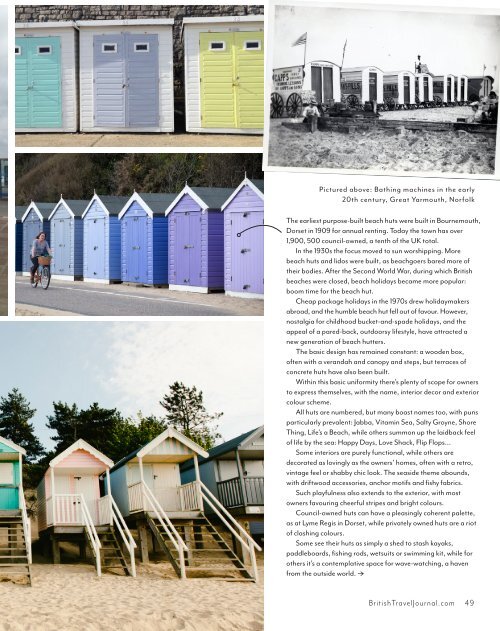British Travel Journal | Summer 2020
As we went to print with our last issue never could we have imagined a world in which travel would be completely stopped in its tracks. Never again will we take for granted our freedom to visit our magnificent cityscapes, captivating coastlines and peaceful countryside. It has been a difficult year for the hospitality and travel sector, but as this issue of British Travel Journal shows many are beginning to reopen, delighted to welcome back visitors and guests once more. We speak to these resilient hoteliers, destination managers, and others in the UK tourism industry about how they have responded to COVID-19. Our Cultural Agenda takes on a new direction, exchanging theatre performances for outdoor art, sculptures and natural wonders. And, in a time when remote locations are being sought after, all you need to know about wild (and nearly wild) camping is covered in our Sustainable Travel series. If camping isn’t for you, help is at hand to find the perfect holiday home in our 10 of the Best Self-Catering Properties. If you’re dreaming of strolls along the shore, fresh sea air and gently lapping waves, then you will love our coastal specials; Revival of the Beach Hut, England’s Coast, Wild Swimming and Secret Islands. Enjoy a taste of Cornwall in our Interview with Rick Stein before heading to the beach workshop of wooden bellyboards in our Meet the Maker: Wave Rider article with Dick Pearce. Finally, thank you to all our subscribers for your support, keeping our spirits high with words of encouragement and understanding the unusual delay in receiving this issue. Together we continued to dream of the extraordinary places we can explore, staying inspired with online and digital features, and hopefully by the time of reading this issue our next great adventures will have become reality.Travel safely, and together we will continue to support our wonderful tourism industry.
As we went to print with our last issue never could we have imagined a world in which travel would be completely stopped in its tracks. Never again will we take for granted our freedom to visit our magnificent cityscapes, captivating coastlines and peaceful countryside. It has been a difficult year for the hospitality and travel sector, but as this issue of British Travel Journal shows many are beginning to reopen, delighted to welcome back visitors and guests once more. We speak to these resilient hoteliers, destination managers, and others in the UK tourism industry about how they have responded to COVID-19. Our Cultural Agenda takes on a new direction, exchanging theatre performances for outdoor art, sculptures and natural wonders. And, in a time when remote locations are being sought after, all you need to know about wild (and nearly wild) camping is covered in our Sustainable Travel series. If camping isn’t for you, help is at hand to find the perfect holiday home in our 10 of the Best Self-Catering Properties. If you’re dreaming of strolls along the shore, fresh sea air and gently lapping waves, then you will love our coastal specials; Revival of the Beach Hut, England’s Coast, Wild Swimming and Secret Islands. Enjoy a taste of Cornwall in our Interview with Rick Stein before heading to the beach workshop of wooden bellyboards in our Meet the Maker: Wave Rider article with Dick Pearce. Finally, thank you to all our subscribers for your support, keeping our spirits high with words of encouragement and understanding the unusual delay in receiving this issue. Together we continued to dream of the extraordinary places we can explore, staying inspired with online and digital features, and hopefully by the time of reading this issue our next great adventures will have become reality.Travel safely, and together we will continue to support our wonderful tourism industry.
You also want an ePaper? Increase the reach of your titles
YUMPU automatically turns print PDFs into web optimized ePapers that Google loves.
Pictured above: Bathing machines in the early<br />
20th century, Great Yarmouth, Norfolk<br />
The earliest purpose-built beach huts were built in Bournemouth,<br />
Dorset in 1909 for annual renting. Today the town has over<br />
1,900, 500 council-owned, a tenth of the UK total.<br />
In the 1930s the focus moved to sun worshipping. More<br />
beach huts and lidos were built, as beachgoers bared more of<br />
their bodies. After the Second World War, during which <strong>British</strong><br />
beaches were closed, beach holidays became more popular:<br />
boom time for the beach hut.<br />
Cheap package holidays in the 1970s drew holidaymakers<br />
abroad, and the humble beach hut fell out of favour. However,<br />
nostalgia for childhood bucket-and-spade holidays, and the<br />
appeal of a pared-back, outdoorsy lifestyle, have attracted a<br />
new generation of beach hutters.<br />
The basic design has remained constant: a wooden box,<br />
often with a verandah and canopy and steps, but terraces of<br />
concrete huts have also been built.<br />
Within this basic uniformity there’s plenty of scope for owners<br />
to express themselves, with the name, interior decor and exterior<br />
colour scheme.<br />
All huts are numbered, but many boast names too, with puns<br />
particularly prevalent: Jabba, Vitamin Sea, Salty Groyne, Shore<br />
Thing, Life’s a Beach, while others summon up the laidback feel<br />
of life by the sea: Happy Days, Love Shack, Flip Flops…<br />
Some interiors are purely functional, while others are<br />
decorated as lovingly as the owners’ homes, often with a retro,<br />
vintage feel or shabby chic look. The seaside theme abounds,<br />
with driftwood accessories, anchor motifs and fishy fabrics.<br />
Such playfulness also extends to the exterior, with most<br />
owners favouring cheerful stripes and bright colours.<br />
Council-owned huts can have a pleasingly coherent palette,<br />
as at Lyme Regis in Dorset, while privately owned huts are a riot<br />
of clashing colours.<br />
Some see their huts as simply a shed to stash kayaks,<br />
paddleboards, fishing rods, wetsuits or swimming kit, while for<br />
others it’s a contemplative space for wave-watching, a haven<br />
from the outside world. à<br />
<strong>British</strong><strong>Travel</strong><strong>Journal</strong>.com 49


















